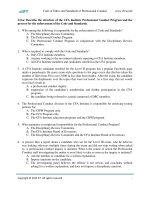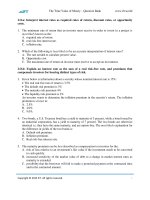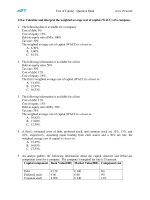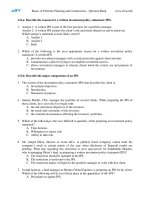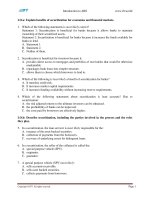CFA 2018 r17 principles of asset allocation
Bạn đang xem bản rút gọn của tài liệu. Xem và tải ngay bản đầy đủ của tài liệu tại đây (1.65 MB, 60 trang )
Level III
Principles of Asset Allocation
www.ift.world
Graphs, charts, tables, examples, and figures are copyright 2017, CFA Institute.
Reproduced and republished with permission from CFA Institute. All rights reserved.
1
Contents and Introduction
1. Introduction
2. Developing Asset-Only Asset Allocations
3. Developing Liability-Relative Asset Allocations
4. Developing Goals-Based Asset Allocations
5. Heuristics and Other Approaches to Asset Allocation
6. Portfolio Rebalancing in Practice
www.ift.world
2
2. Developing Asset-Only Asset Allocations
1. Mean–Variance Optimization: Overview
2. Monte Carlo Simulation
3. Criticisms of Mean–Variance Optimization
4. Addressing the Criticisms of Mean–Variance Optimization
5. Allocating to Less Liquid Asset Classes
6. Risk Budgeting
7. Factor-Based Asset Allocation
www.ift.world
3
2.1 Mean–Variance Optimization: Overview
When assets are not perfectly
correlated they can be combined such
that portfolio risk is less than weighted
average risk of assets themselves.
Returns
Risks
Correlations
Focus on asset’s impact on portfolio
risk, not the risk of the asset itself.
Mean-variance optimization
(MVO) provides a framework for
determining how much to
allocate to each asset in order to
maximize portfolio’s expected
return at a given level of risk.
“MVO is a risk budgeting tool which helps
investors spend their risk budget wisely”
www.ift.world
4
Objective Function
Expected return and standard deviation
are expressed as a percentages.
The expected return of a given asset mix is 10% and the expected standard deviation is 20%. What is the
utility of this asset mix for an investor with a risk aversion coefficient of 2?
www.ift.world
5
Exhibit 1: Hypothetical UK-Based Investor’s Opportunity Set with Expected
Returns, Standard Deviations, and Correlations
www.ift.world
6
www.ift.world
7
Exhibit 3: Efficient Frontier Asset Allocation Area Graph—Base Case
www.ift.world
8
Example 1: Mean–Variance-Efficient Portfolio Choice 1
An investment adviser is counseling Aimée Goddard, a client who recently inherited €1,200,000 and who has
above-average risk tolerance (λ = 2). Because Goddard is young and one of her goals is to fund a comfortable
retirement, she wants to earn returns that will outpace inflation in the long term. Goddard expects to liquidate
€60,000 of the inherited portfolio in 12 months to fund the down payment on a house. She states that it is
important for her to be able to take out the €60,000 without invading the initial capital of €1,200,000. Exhibit 4
shows three alternative strategic asset allocations.
Asset
Allocation
A
B
C
Expected
Return
10.00%
7.00
5.25
Standard Deviation of
Return
20%
10
5
1. Based only on Goddard’s risk-adjusted expected returns for the
asset allocations, which asset allocation would she prefer?
2. Recommend and justify a strategic asset allocation for Goddard.
www.ift.world
9
Determining Allocation to Cash
• Include cash among assets for which efficient frontier is constructed
• Separate cash from risky assets; define efficient frontier based on ‘risky’ assets
▪ Tangency portfolio
▪ Two fund separation
www.ift.world
10
Example 2: A Strategic Asset Allocation Based on Distinguishing
a Nominal Risk-Free Asset
The Cafastani Foundation for the Fine Arts (CFFA) is a hypothetical charitable organization established to provide
funding to Cafastani museums for their art acquisition programs.
CFFA’s overall investment objective is to maintain its portfolio’s real purchasing power after distributions. CFFA
targets a 4% annual distribution of assets. CFFA has the following current specific investment policies.
Return objective
CFFA’s assets shall be invested with the objective of earning an average nominal 6.5% annual return. This level
reflects a spending rate of 4%, an expected inflation rate of 2%, and a 40 bp cost of earning investment returns.
The calculation is (1.04)(1.02)(1.004) – 1 = 0.065, or 6.5%.
Risk considerations
CFFA’s assets shall be invested to minimize the level of standard deviation of return subject to satisfying the
expected return objective.
The investment office of CFFA distinguishes a nominally risk-free asset. As of the date of the optimization, the riskfree rate is determined to be 2.2%.
Exhibit 5 gives key outputs from a mean–variance optimization in which asset class weights are constrained to be
non-negative.
www.ift.world
11
Portfolio
Number
1
2
3
4
5
6
7
Expected Nominal Returns
9.50%
8.90
8.61
7.24
5.61
5.49
3.61
Standard
Deviation
18.00%
15.98
15.20
11.65
7.89
7.65
5.39
Sharpe
Ratio
0.406
0.419
0.422
0.433
0.432
0.430
0.262
The portfolios shown are corner
portfolios which as a group define
the risky-asset efficient frontier in
the sense that any portfolio on the
frontier is a combination of the two
corner portfolios that bracket it in
terms of expected return.
Based only on the facts given, determine the most appropriate strategic asset allocation for CFFA given its stated
investment policies.
www.ift.world
12
Asset Allocation and Economic Balance Sheet
Emma Beel is a 45-year-old tenured
university professor in London. Capital
market assumptions are as before (see
Exhibit 1). Beel has GBP 1,500,000 in liquid
financial assets, largely due to a bestselling book. Her employment as a tenured
university professor is viewed as very
secure and produces cash flows that
resemble those of a very large, inflationadjusted, long-duration bond portfolio. The
net present value of her human capital is
estimated at GBP 500,000. Beel inherited
her grandmother’s home on the edge of
the city, valued at GBP 750,000.
www.ift.world
13
2.2 Monte Carlo Simulation
Input variables
Time horizon
Cash inflows/outflows
Monte Carlo
Simulator
Range of
outcomes
• Monte Carlo simulation complements MVO
▪ Handles multiple periods
▪ Realistic picture of potential future outcomes
▪ Impact of trading, rebalancing and tax costs
• Monte Carlo simulation is particularly important when there cash inflows/outflows and returns vary
over time
• Monte Carlo simulation allows us to evaluate robustness of an asset allocation
www.ift.world
14
Example 3: Monte Carlo Simulation for a Retirement Portfolio
with a Proposed Asset Allocation
Malala Ali, a resident of the hypothetical country of Cafastan, has sought the advice of an investment adviser concerning her
retirement portfolio. At the end of 2017, she is 65 years old and holds a portfolio valued at CAF$1 million. Ali would like to
withdraw CAF$40,000 a year to supplement the corporate pension she has begun to receive. Given her health and family history,
Ali believes she should plan for a retirement lasting 25 years. She is also concerned about passing along a portion of her portfolio
to the families of her three children; she hopes that at least the portfolio’s current real value can go to them. Consulting with her
adviser, Ali has expressed this desire quantitatively: She wants the median value of her bequest to her children to be no less than
her portfolio’s current value of CAF$1 million in real terms. The median is the 50th percentile outcome. The asset allocation of
her retirement portfolio is currently 50/50 Cafastani equities/Cafastani intermediate-term government bonds. Ali and her adviser
have decided on the following set of capital market expectations
Asset Class
Cafastani equities
Cafastani bonds
Inflation
Expected Return
9.4%
5.6%
2.6%
Standard Deviation of Return
20.4%
4.1%
The predicted correlation between returns of Cafastani equities and Cafastani intermediate-term government bonds is 0.15.
With the current asset allocation, the expected nominal return on Ali’s retirement portfolio is 6.7% with a standard deviation of
11%. Exhibit 9 gives the results of the Monte Carlo simulation.
www.ift.world
15
Exhibit 9: Monte Carlo Simulation of Ending Real Wealth with Annual Cash Outflows
www.ift.world
16
2.3 Criticisms of Mean–Variance Optimization
1.
The outputs (asset allocations) are highly sensitive to small changes in the inputs.
2.
The asset allocations tend to be highly concentrated in a subset of the available asset classes.
3.
Many investors are concerned about more than the mean and variance of returns, the focus of
MVO.
4.
Although the asset allocations may appear diversified across assets, the sources of risk may not be
diversified.
5.
Most portfolios exist to pay for a liability or consumption series, and MVO allocations are not
directly connected to what influences the value of the liability or the consumption series.
6.
MVO is a single-period framework that does not take account of trading/rebalancing costs and
taxes.
www.ift.world
17
Impact on portfolio weights when there is small change in inputs
Expected return of Asia Pacific Ex Japan changed from 8.5% to 9.0% and expected return of Europe ex UK equities
changed from 8.6% to 8.1%.
www.ift.world
18
2.4 Addressing the Criticisms of Mean–Variance Optimization
Quality of inputs can be improved by using reverse optimization
Asset class returns
risks, correlations
Asset class returns
Black-Litterman
Asset class returns
which reflect
investor’s views
Mean Variance Optimization
Risk aversion
Reverse Optimization
Investment
opportunity set
Global market
portfolio
Asset class risks, correlations
and risk tolerance
The Black–Litterman model starts with excess returns produced
from reverse optimization and then provides a technique for
altering reverse-optimized expected returns in such a way that they
reflect an investor’s own distinctive views yet still behave well in an
optimizer.
Investors can provide their views/forecasts as absolute return
forecasts or as returns relative to other asset(s).
www.ift.world
19
Adding Constraints Beyond the Budget Constraint
Standard constraints used in mean-variance optimization
• Budget (unity) constraint: sum of asset class weights = 1
• Non-negativity constraint
Additional constraints used to:
Other possible constraints:
1) Incorporate real-world constraints
1. Specify a set allocation to a specific asset.
2) Overcome shortcomings of MVO
2. Specify an asset allocation range for an asset.
3. Specify an upper limit, due to liquidity considerations.
4. Specify the relative allocation of two or more assets.
5. Hold one or more assets representing the systematic characteristics of the liability short.
Good constraints:
1) model the actual circumstances
2) reflect context in which one is attempting to set asset allocation policy
www.ift.world
20
Resampled Mean-Variance Optimization
Multiple variations
of capital market
assumptions
Simulated
frontiers
Asset allocations
(portfolio weights)
from simulated
frontiers are saved
and averaged.
Coupled
with starting
CME
Resampled
Efficient
Frontier
• Resampled MVO combines MVO
with Monte Carlo simulation
• Leads to more diversified asset
allocation
• Recognizes that forward looking
estimates are inherently subject
to error
www.ift.world
21
Other Non-Normal Optimization Approaches
• MVO focuses on mean and variance while investors might also be concerned about skewness and
kurtosis
• Asset returns are not normally distributed
▪ Extreme returns occur 10 times more frequently than what the normal distribution would
suggest
▪ Pain of loss is about twice as significant as joy from equivalent gain
Key Non-Normal Frameworks
Mean–semivariance optimization
Mean–conditional value-at-risk optimization
Mean–variance-skewness optimization
Mean–variance-skewness-kurtosis optimization
www.ift.world
22
Example 4: Problems in Mean–Variance Optimization (1/3)
In a presentation to US-based investment clients on asset allocation, the results of two asset allocation
exercises are shown, as presented in Exhibit 18. There are a total of 9 asset classes.
Based on mean–variance analysis, what is
the asset allocation that would most likely
be selected by a risk-neutral investor?
Based only on the information that can be
inferred from Panel A, discuss the
investment characteristics of non-US
developed market equity (NUSD) in
efficient portfolios.
Critique the efficient asset mixes
represented in Panel A.
www.ift.world
23
Example 4: Problems in Mean–Variance Optimization (2/3)
Compare the asset allocations shown in Panel A with the corresponding asset allocations shown in Panel B.
www.ift.world
24
Example 4: Problems in Mean–Variance Optimization (3/3)
Identify three techniques that the asset allocations in Panel B might have incorporated to improve the
characteristics relative to those of Panel A.
Discuss how the techniques described in your answer to 3A address the high input sensitivity of MVO.
www.ift.world
25


